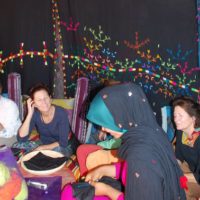Travel to Morocco in Fall 2016
- TAC
- Apr 13, 2015
- 2 min read

Textile Arts Council Tour to Morocco
September 19 to October 3, 2016
The lure of a textile tour to Morocco was so strong that the Textile Arts Council offered two tours to satisfy the many requests. The first tour was from September 19 to October 3rd and the second from October 4th to October 18th.
Starting in Casablanca, the tour traveled east to Fes, stopping along the way at the charming Roman ruins in Volubilis. In addition to exploring the narrow streets of the Fes medina, there was a short drive to Sefrou to visit its market and to have a workshop featuring the intricate buttons created there. These buttons are an important decorative element in a woman’s kaftan as well as the djellaba, or loose fitting outer robe, worn by both men and women. One of the highlights of our visit to Fes was witnessing weaving using a draw-boy loom. It is amazing that this 16th century technology continues to be used in creating contemporary fabric.
We next drove south, along the Atlas Mountains enroute to Marrakech. There were stops in Erfoud and Rissani as well as the artist’s retreat, Café Tissardmine, where we had the opportunity to try our hand at weaving Berber rugs and tents as well as embroidering Berber haik or head covers. For many of us, the great adventure of riding a camel into the dunes to see the sunset and then spending the night in a tent very similar to the one we had just witnessed a woman weaving was thrilling.
Before reaching Marrakech we stopped at the southern town of Ouarzazate and had the opportunity to visit nearby Taznaght which is famous for finely woven carpets. Both groups greatly enjoyed the opportunity to learn more about Berber carpet weaving at the Association Iklan Tissage Berbere. Our drive in the mountains allowed us a unique opportunity to see everyday life in Morocco. From verdant oasis towns to remote nomadic encampments the vivid tapestry of life was enchanting. We even came across nomadic goat herders who still make their homes in caves in the Dades Gorge.
Our time in Marrakech was divided between visits to beautiful historic sites such as the Bahia Palace and wonderful museums such as the Tiskiwin and Marjorelle Gardens and Museum. One of the highlights of the trip was the visit to the home of a collector of Berber textiles who generously shared a number of extraordinary textiles with the groups. Of course, there were also visits to the busy Djemaa el Fna, the central square loaded with many tempting treasures.
We were very fortunate to have as our land guide Redouane El Aouan. His depth of knowledge of Moroccan history and culture and his ability to share insights into current affairs as well as his ability to navigate the mazes of the medina in Fes and Marrakech enriched our understanding of who and what we were seeing. We all came away with a much greater understanding of Morocco and its place in the world thanks to him.










Comments